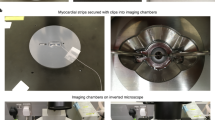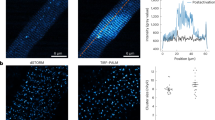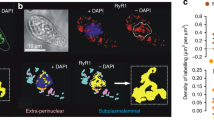Abstract
Calcium is believed to control a variety of cellular processes, often with a high degree of spatial and temporal precision. For a cell to use Ca2+ in this manner, mechanisms must exist for controlling the ion in a localized fashion. We have now gained insight into such mechanisms from studies which measured Ca2+ in single living cells with high resolution using a digital imaging microscope and the highly fluorescent Ca2+-sensitive dye, Fura-2. Levels of Ca2+ in the cytoplasm, nucleus and sarcoplasmic reticulum (SR) are clearly different. Free [Ca2+] in the nucleus and SR was greater than in the cytoplasm and these gradients were abolished by Ca2+ ionophores. When external Ca2+ was raised above normal in the absence of ionophores, free cytoplasmic Ca2+ increased but nuclear Ca2+ did not. Thus, nuclear [Ca2+] appears to be regulated independently of cytoplasmic [Ca2+] by gating mechanisms in the nuclear envelope. The observed regulation of intranuclear Ca2+ in these contractile cells may thus be seen as a way to prevent fluctuation in Ca2+-linked nuclear processes during the rise in cytoplasmic [Ca2+] which triggers contraction. The approach described here offers the opportunity of following changes in Ca2+ in cellular compartments in response to a wide range of stimuli, allowing new insights into the role of local changes in Ca2+ in the regulation of cell function.
This is a preview of subscription content, access via your institution
Access options
Subscribe to this journal
Receive 51 print issues and online access
$199.00 per year
only $3.90 per issue
Buy this article
- Purchase on Springer Link
- Instant access to full article PDF
Prices may be subject to local taxes which are calculated during checkout
Similar content being viewed by others
References
Fay, F. S., Hoffmann, R., LeClair, S. & Merriam, P. Meth. Enzym. 85, 284–292 (1982).
Grynkiewicz, G., Poenie, M. & Tsien, R. Y. J. biol. Chem. 260, 3440–3450 (1985).
Fay, F. S., Rees, D. D. & Warshaw, D. M. in Membrane Structure and Function Vol. 4 (ed. Bittar, E.) 80–130 (Wiley, New York, 1981).
Murray, J. J., Reed, P. W. & Fay, F. S. Proc. natn. Acad. Sci. U.S.A. 72, 4459–4463 (1975).
Fay, F. S., Schlevin, H., Granger, B. & Taylor, S. R. Nature 280, 506–508 (1979).
Williams, D. A. & Fay, F. S. Am. J. Physiol. (in the press).
Fay, F. S., Fogarty, K. E. & Coggins, J. M. in Optical Methods in Cell Physiology (eds DeWeer, P. & Salzburg, B.) (Wiley, New York, in the press).
Bond, M., Shuman, H., Somlyo, A. P. & Somlyo, A. V. J. Physiol. Lond. 357, 185–201 (1984).
Paine, P.L., Pearson, T. W., Tluczek, L.J.M. & Horowitz, S. B. Nature 291, 258–261 (1981).
Palmer, L. G. & Civan, M. M. J. Membrane Biol. 33, 41–61 (1977).
Unwin, P. N. T. & Milligan, R. A. J. Cell Biol. 93, 63–75 (1982).
Bonner, W. M. in The Cell Nucleus (ed. Busch, H.) 97–148 (Academic, New York, 1978).
Dingwade, C., Sharnick, S. V. & Laskey, R. A. Cell 30, 449–458 (1982).
Feldherr, C. M., Kallenbach, E. & Salrutz, N. J. Cell Biol. 99, 2216–2222, (1984).
Laskey, R. A., Honda, B. M., Millis, A. D. & Finch, J. T. Nature 275, 416–420 (1978).
Kulikova, O. G., Savostianov, G. A., Beliavtseva, L. M. & Razumovskaia, N. I. Biokhimica 47, 1216–1221 (1982).
Popescu, L. M. in Excitation-Contraction Coupling in Smooth Muscle (eds Casteels, R., Godfraind, T. & R¼ege, J. C.) (Elsevier, Amsterdam, 1977).
Somlyo, A. P., Somlyo, A. V., Shuman, H. & Endo, M. Fedn Proc. 41, 2883–2890 (1982).
Kowarski, D., Shuman, H., Somlyo, A. P. & Somlyo, A. V. J. Physiol., Lond. 366, 153–175 (1985).
Harper, J. F. et al. Proc. natn. Acad. Sci. U.S.A. 77, 366–370 (1980).
Maizels, E. T. & Jungmann, R. A. Endocrinology 112, 1895–1902 (1983).
Pardo, J. P. & Fernandez, F. FEBS Lett. 143, 157–160 (1982).
Simmen, R. C. M. et al. J. Cell Biol. 99, 588–593 (1984).
White, B. A. J. biol. Chem. 260, 1213–1217 (1985).
Moisescu, D. G. & Thieleczek, R. J. Physiol., Lond. 275, 241–262 (1978).
Stephenson, D. G. & Williams, D. A. J. Physiol., Lond. 317, 281–302 (1981).
Lakowiez, J.R. Principles of Fluorescence Microscopy (Plenum, New York, 1983).
Author information
Authors and Affiliations
Rights and permissions
About this article
Cite this article
Williams, D., Fogarty, K., Tsien, R. et al. Calcium gradients in single smooth muscle cells revealed by the digital imaging microscope using Fura-2. Nature 318, 558–561 (1985). https://doi.org/10.1038/318558a0
Received:
Accepted:
Published:
Issue Date:
DOI: https://doi.org/10.1038/318558a0
This article is cited by
-
Calcium signaling: breast cancer’s approach to manipulation of cellular circuitry
Biophysical Reviews (2020)
-
Impaired smooth muscle cell contractility as a novel concept of abdominal aortic aneurysm pathophysiology
Scientific Reports (2019)
-
Improved calcium sensor GCaMP-X overcomes the calcium channel perturbations induced by the calmodulin in GCaMP
Nature Communications (2018)
-
From contraction to gene expression: nanojunctions of the sarco/endoplasmic reticulum deliver site- and function-specific calcium signals
Science China Life Sciences (2016)
-
Nuclear calcium signalling in the regulation of brain function
Nature Reviews Neuroscience (2013)
Comments
By submitting a comment you agree to abide by our Terms and Community Guidelines. If you find something abusive or that does not comply with our terms or guidelines please flag it as inappropriate.



